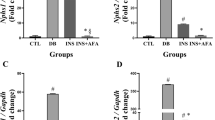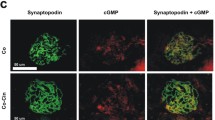Abstract
The up-regulation of angiotensin II AT1 receptors has been implicated as a major mediator in the development of hypertension and progressive nephropathy in experimental diabetes. In spite of the documented potential of garlic treatments in ameliorating diabetic complications, the possible involvement of the angiotensin II AT1 receptor, as a central target for the anti-diabetic potential of garlic, has not been explored. Three groups of rats were studied after 8 weeks following diabetes induction: normal, streptozotocin-induced diabetic (control diabetic), and garlic-treated diabetic rats. A polyclonal antibody of proven specificity to the AT1 receptor, as verified by western blotting, indicated in immunohistochemical assays that AT1 receptor labeling was significantly increased in adrenal and renal tissues of control diabetic rats compared to the normal group. The increased AT1 receptor labeling involved all cortical zones and medullary chromaffin cells of the adrenal gland. Except for glomerulii, increased AT1 receptor labeling was also evident in proximal convoluted tubules in the renal cortex, and all tubular segments and interstitial cells outlining the vasa recta bundles in the inner stripe of the outer renal medulla. Compared with control diabetic rats, the labeling of the AT1 receptor in the garlic-treated diabetic group was significantly reduced throughout adrenal and renal regions to levels comparable to those observed in normal rats. The capacity of garlic to modulate diabetes-induced AT1 receptor up-regulation may be implicated in reversing the detrimental consequences of excessive Ang II signaling, manifested by the development of hypertension and nephropathy.







Similar content being viewed by others
References
Ahmad MS, Ahmed N (2006) Antiglycation properties of aged garlic extract: possible role in prevention of diabetic complication. J Nutr 136:796S–799S
Ahmad MS, Pischetsrieder M, Ahmed N (2007) Aged garlic extract and S-allyl cysteine prevents formation of advanced glycation endproducts. Eur J Pharmacol 561(1–3):32–38
Al-Qattan K, Al-Akhawand S, Mansour MH (2006) Immunohistochemical localization of distinct angiotensin II AT1 receptor isoforms in the kidneys of the Sprague-Dawley rat and the desert rodent Meriones crassus. Anat Histol Embryol 35:130–138
Al-Qattan K, Thomson M, Ali M (2008) Garlic (Allium sativum) and ginger (Zingiber officinale) attenuate structural nephropathy progression in streptozotocin-induced diabetic rats. e-SPN. doi:10.1016/j.eclnm
Amagase H (2006) Clarifying the real bioactive constituents of garlic. J Nutr 136:716S–725S
Atlas SA (2007) The renin-angiotensin aldosterone system: patho-physiological role and pharmacologic inhibition. J Manag Care Pharm 13(8):S9–S20
Banday AA, Lokhandwala MF (2008) Oxidative stress-induced renal angiotensin AT1 receptor upregulation causes increased stimulation of sodium transporters and hypertension. Am J Physiol Renal Physiol 295:F698–F706
Becker M, Umrani D, Lokhandwala MF, Hussain T (2003) Increased renal angiotensin II AT1 receptor function in obese Zucker rat. Clin Exp Hypertens 25:35–47
Brenner BM, Cooper ME, de Zeeuw D et al (2001) Effects of losartan on renal and cardiovascular outcomes in patients with type 2 diabetes mellitus and nephropathy. N Engl J Med 345:861–869
Brewster UC, Perazella MA (2004) The renin-angiotensin-aldosterone system and the kidney: effects on kidney disease. Am J Med 116(4):263–272
Brown L, Wall D, Marchant C, Sernia C (1997) Tissue-specific changes in angiotensin II receptors in streptozotocin-diabetic rats. J Endocrinol 154(2):355–362
Burns KD (2000) Angiotensin II and its receptors in the diabetic kidney. Am J Kidney Dis 36(3):449–467
Drobiova H, Thomson M, Al-Qattan K et al (2009) Garlic increases antioxidant levels in diabetic and hypertensive rats determined by a modified peroxidase method. eCAM. doi:10.1093/ecam/nep011
Giles EM, Fernley RT, Nakamura Y et al (1999) Characterization of a specific antibody to the rat angiotensin II AT1 receptor. J Histochem Cytochem 47:507–515
Gnudi L, Goldsmith D (2010) Renin angiotensin aldosterone system (RAAS) inhibitors in the prevention of early renal disease in diabetes. Med Rep 2(18):1–4
Higuchi S, Ohtsu H, Suzuki H et al (2007) Angiotensin II signal transduction through the AT1 receptor: novel insights into mechanisms and pathophysiology. Clin Sci (Lond) 112:417–428
Hosseini M, Shafiee SM, Baluchnejadmojarad T (2007) Garlic extract reduces serum angiotensin converting enzyme (ACE) activity in nondiabetic and streptozotocin-diabetic rats. Pathophysiology 14(2):109–112
Jayadev S, Smith RD, Jagadeesh G, Baukal AJ, Hunyady L, Catt KJ (1999) N-linked glycosylation is required for optimal AT1a angiotensin receptor expression in COS-7 cells. Endocrinology 140:2010–2017
Kagami S, Border WA, Miller DE, Noble NA (1994) Angiotensin II stimulates extracellular matrix protein synthesis through induction of transforming growth factor-beta expression in rat glomerular mesangial cells. J Clin Invest 93:2431–2437
Kalinyak JE, Sechi LA, Griffin CA et al (1993) The rennin angiotensin system in streptozotocin-induced diabetes mellitus in the rat. J Am Soc Nephrol 4:1337–1345
Kaschina E, Unger T (2003) Angiotensin AT1/AT2 receptors: regulation, signaling and function. Blood Press 12:70–88
Kasuga S, Ushijima M, Morihara N et al (1999) Effect of aged garlic extract (AGE) on hyperglycemia induced by immobilization stress in mice. Nippon Yakurigaku Zasshi 114(3):191–197
Kennefick TM, Oyama TT, Thompson MM et al (1996) Enhanced renal sensitivity to angiotensin actions in diabetes mellitus in the rat. Am J Physiol 271:595–602
Kobori H, Nangaku M, Navar LG, Nishiyama A (2007) The intrarenal renin-angiotensin system: from physiology to the pathobiology of hypertension and kidney disease. Pharmacol Rev 59:251–287
Laemmli UK (1970) Cleavage of structural protein during the assembly of the head of bacteriophage T4. Nature 227:680–685
Lanctôt PM, Leclerc PC, Clemente M, Auger-Messier M, Escher E, Leduc R, Guillemette G (2005) Importance of N-glycosylation positioning for cell-surface expression, targeting, affinity and quality control of the human AT1 receptor. Biochem J 390:367–376
Lanctôt PM, Leclerc PC, Escher E, Guillemette G, Leduc R (2006) Role of N-glycan-dependent quality control in the cell-surface expression of the AT1 receptor. Biochem Biophys Res Commun 340(2):395–402
Lewis EJ, Hunsicker LG, Clarke WR et al (2001) Renoprotective effect of the angiotensin-receptor antagonist irbesartan in patients with nephropathy due to type 2 diabetes. N Engl J Med 345:851–860
Liu CT, Sheen LY, Lii CK (2007) Does garlic have a role as an anti-diabetic agent? Mol Nutr Food Res 51(11):1353–1364
Lowry OH, Rosebrough NJ, Farr AL, Randall RJ (1951) Protein measurement with the folin phenol reagent. J Biol Chem 193:265–275
Murphy TJ, Alexander RW, Griendling KK et al (1991) Isolation of a cDNA encoding the vascular type 1 angiotensin II receptor. Nature 351:233–236
Navar LG, Nishiyama A (2004) Why are angiotensin concentrations so high in the kidney? Curr Opin Nephrol Hypertens 13:107–115
Palumbo PJ (2001) Glycemic control, mealtime glucose excursions, and diabetic complications in type 2 diabetes mellitus. Mayo Clin Proc 76:609–618
Parving HH, Lehnert H, Brochner-Mortensen J et al (2001) Irbesartan in patients with type 2 diabetes and microalbuminuria study group: the effect of irbesartan on the development of diabetic nephropathy in patients with type 2 diabetes. N Engl J Med 345:870–878
Paul M, Poyan Mehr A, Kreutz R (2006) Physiology of local renin-angiotensin systems. Physiol Rev 86:747–803
Pavel J, Benicky J, Larrayoz-Roland I et al (2008) Peripherally administered Angiotensin II AT1 receptor antagonists are anti-stress compounds in vivo. Ann N Y Acad Sci 1148:360–366
Pedraza-Chaverrí J, Barrera D, Maldonado PD et al (2004) S-allylmercaptocysteine scavenges hydroxyl radical and singlet oxygen in vitro and attenuates gentamicin-induced oxidative and nitrosative stress and renal damage in vivo. BMC Clin Pharmacol 4:5–18
Quan A, Baum M (1998) Endogenous angiotensin II modulates rat proximal tubule transport with acute changes in extracellular volume. Am J Physiol Renal Physiol 275:F74–F78
Rábano M, Peña A, Brizuela L et al (2004) Angiotensin II-stimulated cortisol secretion is mediated by phospholipase D. Mol Cell Endocrinol 222(1–2):9–20
Reja V, Goodchild AK, Phillips JK, Pilowsky PM (2006) Upregulation of angiotensin AT1 receptor and intracellular kinase gene expression in hypertensive rats. Clin Exp Pharmacol Physiol 33:690–695
Roberge C, Carpentier AC, Langlois M-F et al (2007) Adrenocortical dysregulation as a major player in insulin resistance and onset of obesity. Am J Physiol Endocrinol Metab 293:E1465–E1478
Shah S, Hussain T (2006) Enhanced angiotensin II-induced activation of Na+, K+-ATPase in the proximal tubules of obese Zucker rats. Clin Exp Hypertens 28:29–40
Sharma K, Jin Y, Cuo J, Ziyadeh FN (1996) Neutralization of TGF-β by anti-TGF-β antibody attenuates kidney hypertrophy and the enhanced extracellular matrix gene expression in STZ-induced diabetic mice. Diabetes 45:522–530
Siragy HM (2004) AT1 and AT2 receptor in the kidney: role in health and disease. Semin Nephrol 24:93–100
Siragy HM, Awad AA, Abadir PM, Webb R (2003) The angiotensin II type 1 receptor mediates renal interstitial content of tumor necrosis factor-α in diabetic rats. Endocrinology 144:2229–2233
Thaiss F, Wolf G, Assad N, Zahner G, Stahl RA (1996) Angiotensinase A gene expression and enzyme activity in isolated glomeruli of diabetic rats. Diabetologia 39:275–280
Thomson M, Al-Amin ZM, Al-Qattan KK et al (2007) Anti-diabetic and hypolipidaemic properties of garlic (Allium sativum) in streptozotocin-induced diabetic rats. Int J Diabetes Metab 15(108–115):42
Vazquez-Prieto MA, González RE, Renna NF et al (2010) Aqueous garlic extracts prevent oxidative stress and vascular remodeling in an experimental model of metabolic syndrome. J Agric Food Chem 58(11):6630–6635
Villa E, Rabano A, Cazes M et al (1997) Effects of UP269-6, a new angiotensin II receptor antagonist, and captopril on the progression of rat diabetic nephropathy. Am J Hypertens 10:275–281
Wehbi GJ, Zimpelmann J, Carey RM et al (2001) Early streptozotocin-diabetes mellitus downregulates rat kidney AT2 receptors. Am J Physiol Renal Physiol 280:F254–F265
Weir MR (2007) Effects of rennin–angiotensin system inhibition on end-organ protection: can we do better? Clin Ther 29(9):1803–1824
Weir MR, Dzau VJ (1999) The renin–angiotensin–aldosterone system: a specific target for hypertension management. Am J Hypertens 12:205S–213S
Wolf G (1998) Molecular mechanisms of angiotensin II in the kidney: emerging role in the progression of renal disease: beyond haemodynamics. Nephrol Dial Transplant 13:1131–1142
Wolf G, Mueller E, Stahl RAK, Ziyadeh FN (1993) Angiotensin II-induced hypertrophy of cultured murine proximal tubular cells is mediated by endogenous transforming growth factor-β. J Clin Invest 92:1366–1372
Wolf G, Sharma K, Chen Y et al (1992) High glucose-induced proliferation in mesangial cells is reversed by autocrine TGF-β. Kidney Int 41(369–402):19
Wolf G, Ziyadeh FN, Stahl RA (1999) Angiotensin II stimulates expression of transforming growth factor beta receptor type II in cultured mouse proximal tubular cells. J Mol Med 77:556–564
Xue C, Siragy HM (2005) Local renal aldosterone system and its regulation by salt, diabetes, and angiotensin II Type 1 receptor. Hypertension 46:584–590
Younis F, Mirelman D, Rabinkov A, Rosenthal T (2010) S-allyl-mercapto-captopril: a novel compound in the treatment of Cohen-Rosenthal diabetic hypertensive rats. J Clin Hypertens 12(6):451–455
Zhuo J, MacGregor DP, Mendelsohn FAO (1996) Comparative distribution of angiotensin II receptor subtypes in mammalian adrenal glands. In: Vinson GP, Anderson DC (eds) Adrenal glands, vascular system and hypertension. Journal of Endocrinology Ltd, Bristol, pp 53–68
Zhuo J, Maric C, Harris PJ et al (1997) Localization and functional properties of angiotensin II AT1 receptors in the kidney: focus on renomedullary interstitial cells. Hypertens Res 20:233–250
Ziyadeh FN, Sharma K, Ericksen M, Wolf G (1994) Stimulation of collagen gene expression and protein synthesis in murine mesangial cells by high glucose in mediated by activation of transforming growth factor-β. J Clin Invest 93:536–542
Acknowledgments
Supported by Research Project # 2007-1302-04 funded by Kuwait Foundation for the Advancement of Science and Research Projects # SL 06/08 and 09/10, funded by Kuwait University.
Conflict of interest
The authors are not employees or consultants associated with any commercial company, and there were no conflicts of interest in the present study.
Author information
Authors and Affiliations
Corresponding author
Rights and permissions
About this article
Cite this article
Mansour, M.H., Al-Qattan, K., Thomson, M. et al. Garlic (Allium sativum) down-regulates the expression of angiotensin II AT1 receptor in adrenal and renal tissues of streptozotocin-induced diabetic rats. Inflammopharmacol 21, 147–159 (2013). https://doi.org/10.1007/s10787-012-0139-3
Received:
Accepted:
Published:
Issue Date:
DOI: https://doi.org/10.1007/s10787-012-0139-3




